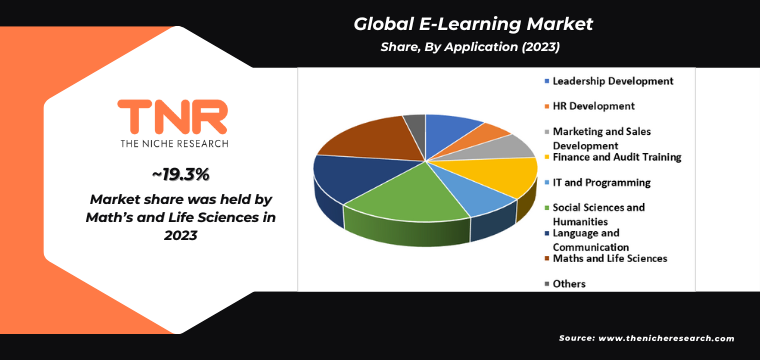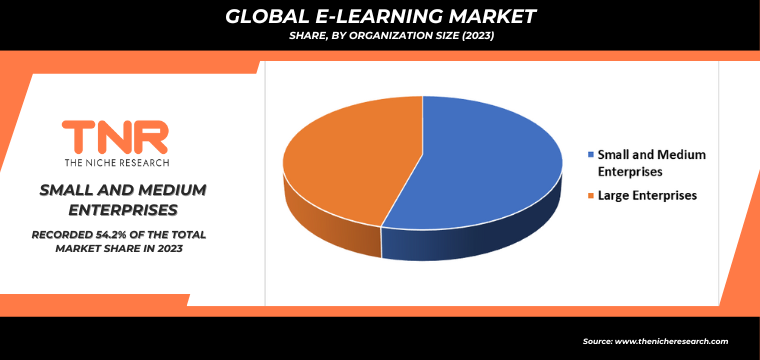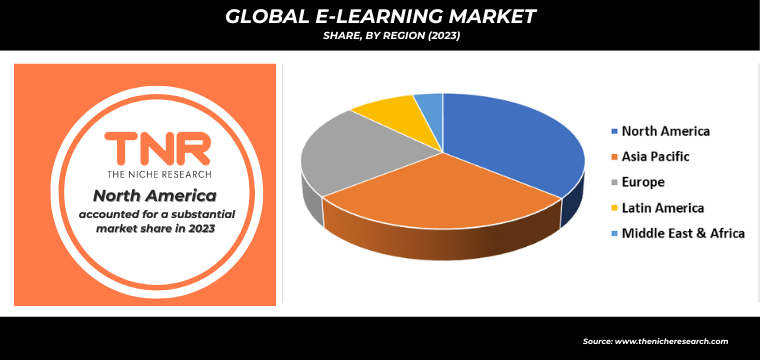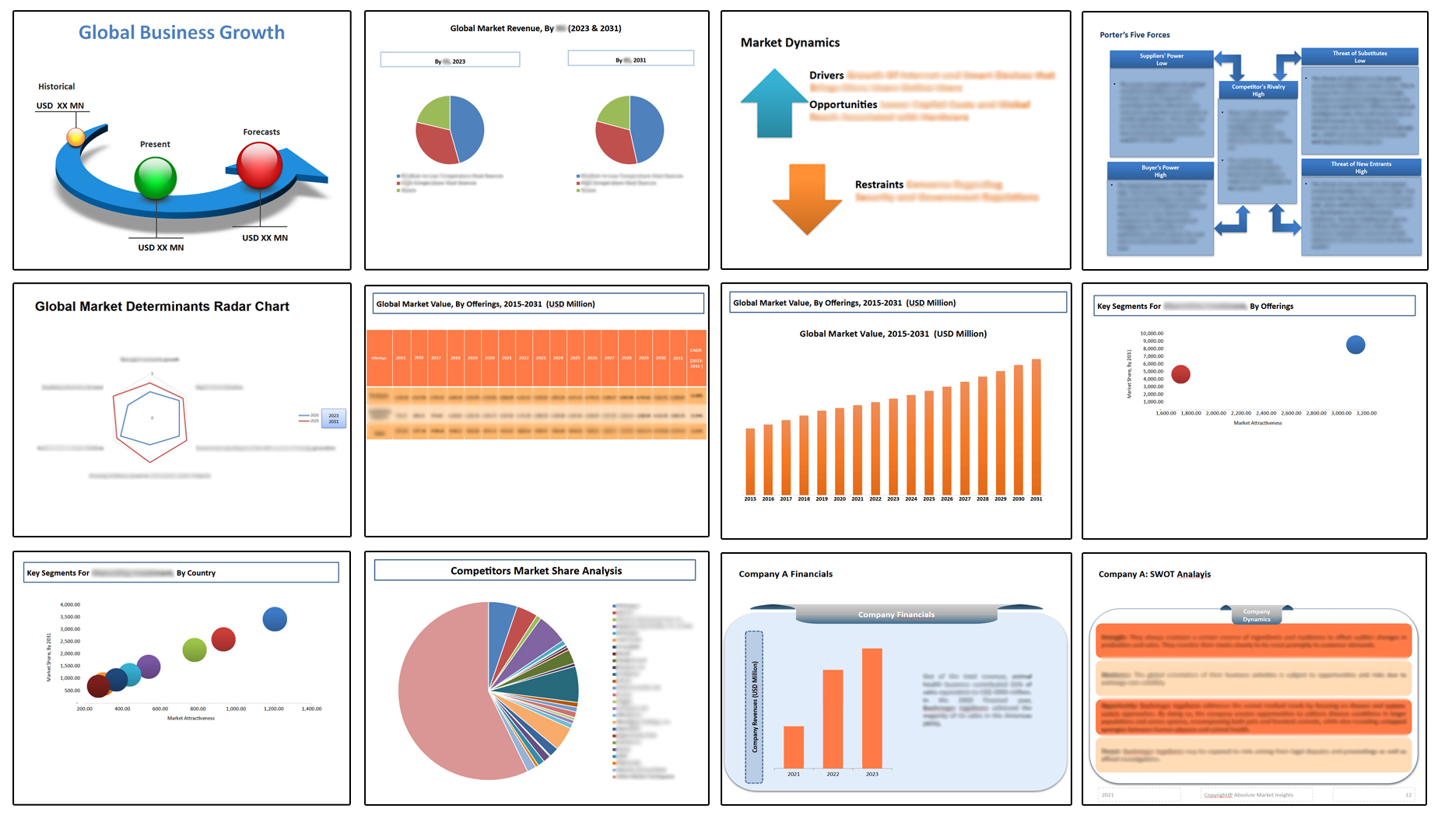Global E-Learning Market By Delivery Mode, By Application, By Learning Type, By Platform, By Organization Size, By End User, By Region & Segmental Insights Trends and Forecast, 2024 – 2034
- Industry: Technology
- Report ID: TNR-110-1130
- Number of Pages: 420
- Table/Charts : Yes
- June, 2024
- Base Year : 2024
- No. of Companies : 10+
- No. of Countries : 29
- Views : 10238
- Covid Impact Covered: Yes
- War Impact Covered: Yes
- Formats : PDF, Excel, PPT
The global e-learning market is experiencing robust growth, driven by technological advancements, increased internet penetration, and the rising demand for flexible and remote learning options. Key drivers include the proliferation of smartphones, the need for upskilling in a rapidly evolving job market, and the adoption of AI and AR/VR technologies. Opportunities abound in emerging markets, where internet access is expanding, and in corporate training, where e-learning is cost-effective and scalable. Trends such as personalized learning, gamification, and mobile learning are shaping the market, making education more accessible, engaging, and tailored to individual needs. This dynamic landscape promises continued innovation and expansion.
In terms of revenue, the global e-learning market was worth US$ 317.7 Bn in 2023 and is anticipated to witness a CAGR of 19.5% during 2024 – 2034.

Trends in the Global E-Learning Market
- Rise of AI and Personalized Learning- Artificial Intelligence (AI) is significantly transforming the global e-learning market. AI-powered tools are enabling personalized learning experiences by adapting content and assessments to meet individual learner needs. This technology analyzes learners’ strengths, weaknesses, and preferences, offering tailored recommendations and resources. AI-driven chatbots and virtual tutors provide instant assistance, enhancing engagement and comprehension. Furthermore, AI’s ability to process vast amounts of data ensures continuous improvement in learning materials and methodologies, making education more effective and accessible. As a result, the integration of AI is fostering a more dynamic, interactive, and student-centric e-learning environment.
- Growth of Mobile Learning- Mobile learning, or m-learning, is rapidly gaining traction in the global e-learning market. With the increasing penetration of smartphones and tablets, learners can access educational content anytime, anywhere. This trend is driven by the flexibility and convenience mobile devices offer, catering to the needs of a diverse and global audience. E-learning platforms are optimizing their interfaces for mobile use, incorporating multimedia content, gamification, and microlearning techniques to enhance user engagement. The proliferation of mobile apps dedicated to learning is making education more accessible, especially in remote and underserved areas, thereby democratizing knowledge and skills acquisition worldwide.
Videos segment by delivery mode has dominated the global e-learning market during the forecast period due to its engaging and versatile nature. Video-based content enhances understanding and retention by combining visual and auditory elements, making complex concepts easier to grasp. It caters to various learning styles and can be accessed on-demand, fitting into diverse schedules. The popularity of platforms like YouTube and educational portals has further propelled this trend, with high-quality, interactive video tutorials and lectures becoming a cornerstone of modern e-learning strategies.

Social sciences and humanities segment by application has seen significant popularity and is projected to grow the fastest over the forecast timeline. This surge is driven by increasing recognition of the value of these disciplines in fostering critical thinking, cultural awareness, and societal understanding. E-learning platforms are expanding their offerings in subjects like psychology, sociology, history, and philosophy, making them accessible to a broader audience. Interactive content, online discussions, and multimedia resources enhance engagement, attracting students and lifelong learners alike, thus fuelling rapid growth in this segment.

In 2023, the instructor-led segment by learning type captured the largest revenue share in the global e-learning market, accounting for 51.8%. This dominance reflects the continued preference for structured, interactive learning experiences guided by expert educators. Instructor-led training (ILT) provides real-time feedback, fosters collaborative learning, and allows for personalized instruction, which enhances comprehension and retention. The blending of traditional teaching methods with digital tools in virtual classrooms has further strengthened this segment, making it a vital component of the e-learning landscape.

App-based segment by platform dominated the global e-learning market during the forecast period, driven by the widespread use of smartphones and tablets. E-learning apps offer unparalleled convenience, allowing learners to access educational content anytime, anywhere. These apps often feature interactive elements, gamification, and personalized learning paths, enhancing user engagement and retention. The increasing availability of educational apps across diverse subjects and languages has broadened access to learning resources, catering to various age groups and educational needs, thereby solidifying the dominance of the app-based segment.

Large enterprises segment by organization size has gained significant popularity in recent years and is anticipated to grow the fastest over the forecast timeline. This growth is driven by the need for scalable, efficient training solutions to upskill employees and maintain competitive advantage. E-learning platforms provide large enterprises with cost-effective, flexible training programs that can be customized to meet diverse organizational needs. Additionally, the integration of advanced technologies such as AI and analytics helps these enterprises track and optimize employee learning outcomes, further fueling the segment’s rapid expansion.

Individuals segment by end user has gained significant popularity in recent years and is anticipated to grow the fastest over the forecast timeline. This surge is driven by the increasing demand for personalized learning experiences and the flexibility to learn at one’s own pace. E-learning platforms offer a wide array of courses tailored to individual interests and career goals, from professional development to personal enrichment. The rise of affordable, high-quality online education and the growing emphasis on lifelong learning are key factors propelling the rapid growth of this segment.

By region, North America is expected to emerge as the fastest growing region in the e-learning market in 2023. This growth is driven by advanced technological infrastructure, high internet penetration, and the increasing demand for flexible learning solutions. The region’s strong emphasis on continuous professional development and the widespread adoption of e-learning in educational institutions and corporate training programs further fuel this expansion. Additionally, innovations in AI, VR, and mobile learning are enhancing the e-learning experience, making North America a leader in the global e-learning landscape.

Competitive Landscape
The competitive landscape of the global e-learning market is characterized by numerous key players, including Coursera, Udemy, and LinkedIn Learning. These companies compete on course variety, technological innovation, and user experience. Mergers, acquisitions, and partnerships are common as firms strive to expand their market presence and enhance their offerings.
Some of the players operating in the e-learning market are
- Absorb LMS Software Inc.
- Adobe
- Alison
- Allen Communication Learning Services
- Blackboard, Inc.
- Cornerstone
- Coursera
- edX, Inc.
- FutureLearn Limited
- Illumina Interactive
- LinkedIn Learning
- Pluralsight
- Skillshare
- Skillsoft
- Spring Solutions
- Udacity
- Udemy, Inc.
- Other Market Participants
Global E-Learning Market Scope
| Report Specifications | Details |
| Market Revenue in 2023 | US$ 317.7 Bn |
| Market Size Forecast by 2034 | US$ 2,254.2 Bn |
| Growth Rate (CAGR) | 19.5% |
| Historic Data | 2016 – 2022 |
| Base Year for Estimation | 2023 |
| Forecast Period | 2024 – 2034 |
| Report Inclusions | Market Size & Estimates, Market Dynamics, Competitive Scenario, Trends, Growth Factors, Market Determinants, Key Investment Segmentation, Product/Service/Solutions Benchmarking |
| Segments Covered | By Delivery Mode, By Application, By Learning Type, By Platform, By Organization Size, By End User, By Region |
| Regions Covered | North America, Europe, Asia Pacific, Middle East & Africa, Latin America |
| Countries Covered | U.S., Canada, Mexico, Rest of North America, France, The UK, Spain, Germany, Italy, Nordic Countries (Denmark, Finland, Iceland, Sweden, Norway), Benelux Union (Belgium, The Netherlands, Luxembourg), Rest of Europe, China, Japan, India, New Zealand, Australia, South Korea, Southeast Asia (Indonesia, Thailand, Malaysia, Singapore, Rest of Southeast Asia), Rest of Asia Pacific, Saudi Arabia, UAE, Egypt, Kuwait, South Africa, Rest of Middle East & Africa, Brazil, Argentina, Rest of Latin America |
| Key Players | Absorb LMS Software Inc., Adobe, Alison, Allen Communication Learning Services, Blackboard, Inc., Cornerstone, Coursera, edX, Inc., FutureLearn Limited, Illumina Interactive, LinkedIn Learning, Pluralsight, Skillshare, Skillsoft, Spring Solutions, Udacity, Udemy, Inc. |
| Customization Scope | Customization allows for the inclusion/modification of content pertaining to geographical regions, countries, and specific market segments. |
| Pricing & Procurement Options | Explore purchase options tailored to your specific research requirements |
| Contact Details | Consult With Our Expert
Japan (Toll-Free): +81 663-386-8111 South Korea (Toll-Free): +82-808- 703-126 Saudi Arabia (Toll-Free): +966 800-850-1643 United Kingdom: +44 753-710-5080 United States: +1 302-232-5106 E-mail: askanexpert@thenicheresearch.com
|
Global E-Learning Market
By Delivery Mode
- eBooks
- Videos
- Recorded Webinar
- Simulations
By Application
- Leadership Development
- HR Development
- Marketing and Sales Development
- Finance and Audit Training
- IT and Programming
- Social Sciences and Humanities
- Language and Communication
- Math’s and Life Sciences
- Others
By Learning Type
- Instructor-led
- Self-paced
By Platform
- Web-based
- App-based
By Organization Size
- Small and Medium Enterprises
- Large Enterprises
By End User
- Individuals
- Businesses
- Education
- K-12 Institutes
- Higher Education Institutes
- Information Technology and Telecommunication
- Healthcare
- Banking, Financial Services and Insurance
- Media and Entertainment
- Manufacturing
- Government
- Travel and Hospitality
- Retail and Consumer Goods
- Others
- Education
By Region
- North America (U.S., Canada, Mexico, Rest of North America)
- Europe (France, The UK, Spain, Germany, Italy, Nordic Countries (Denmark, Finland, Iceland, Sweden, Norway), Benelux Union (Belgium, The Netherlands, Luxembourg), Rest of Europe)
- Asia Pacific (China, Japan, India, New Zealand, Australia, South Korea, Southeast Asia (Indonesia, Thailand, Malaysia, Singapore, Rest of Southeast Asia), Rest of Asia Pacific)
- Middle East & Africa (Saudi Arabia, UAE, Egypt, Kuwait, South Africa, Rest of Middle East & Africa)
- Latin America (Brazil, Argentina, Rest of Latin America)
Report Layout:

Table of Contents
Note: This ToC is tentative and can be changed according to the research study conducted during the course of report completion.
**Exclusive for Multi-User and Enterprise User.
Global E-Learning Market
By Delivery Mode
- eBooks
- Videos
- Recorded Webinar
- Simulations
By Application
- Leadership Development
- HR Development
- Marketing and Sales Development
- Finance and Audit Training
- IT and Programming
- Social Sciences and Humanities
- Language and Communication
- Math’s and Life Sciences
- Others
By Learning Type
- Instructor-led
- Self-paced
By Platform
- Web-based
- App-based
By Organization Size
- Small and Medium Enterprises
- Large Enterprises
By End User
- Individuals
- Businesses
- Education
- K-12 Institutes
- Higher Education Institutes
- Information Technology and Telecommunication
- Healthcare
- Banking, Financial Services and Insurance
- Media and Entertainment
- Manufacturing
- Government
- Travel and Hospitality
- Retail and Consumer Goods
- Others
- Education
By Region
- North America (U.S., Canada, Mexico, Rest of North America)
- Europe (France, The UK, Spain, Germany, Italy, Nordic Countries (Denmark, Finland, Iceland, Sweden, Norway), Benelux Union (Belgium, The Netherlands, Luxembourg), Rest of Europe)
- Asia Pacific (China, Japan, India, New Zealand, Australia, South Korea, Southeast Asia (Indonesia, Thailand, Malaysia, Singapore, Rest of Southeast Asia), Rest of Asia Pacific)
- Middle East & Africa (Saudi Arabia, UAE, Egypt, Kuwait, South Africa, Rest of Middle East & Africa)
- Latin America (Brazil, Argentina, Rest of Latin America)
The Niche Research approach encompasses both primary and secondary research methods to provide comprehensive insights. While primary research is the cornerstone of our studies, we also incorporate secondary research sources such as company annual reports, premium industry databases, press releases, industry journals, and white papers.
Within our primary research, we actively engage with various industry stakeholders, conducting paid interviews and surveys. Our meticulous analysis extends to every market participant in major countries, allowing us to thoroughly examine their portfolios, calculate market shares, and segment revenues.
Our data collection primarily focuses on individual countries within our research scope, enabling us to estimate regional market sizes. Typically, we employ a bottom-up approach, meticulously tracking trends in different countries. We analyze growth drivers, constraints, technological innovations, and opportunities for each country, ultimately arriving at regional figures.Our process begins by examining the growth prospects of each country. Building upon these insights, we project growth and trends for the entire region. Finally, we utilize our proprietary model to refine estimations and forecasts.
Our data validation standards are integral to ensuring the reliability and accuracy of our research findings. Here’s a breakdown of our data validation processes and the stakeholders we engage with during our primary research:
- Supply Side Analysis: We initiate a supply side analysis by directly contacting market participants, through telephonic interviews and questionnaires containing both open-ended and close-ended questions. We gather information on their portfolios, segment revenues, developments, and growth strategies.
- Demand Side Analysis: To gain insights into adoption trends and consumer preferences, we reach out to target customers and users (non-vendors). This information forms a vital part of the qualitative analysis section of our reports, covering market dynamics, adoption trends, consumer behavior, spending patterns, and other related aspects.
- Consultant Insights: We tap into the expertise of our partner consultants from around the world to obtain their unique viewpoints and perspectives. Their insights contribute to a well-rounded understanding of the markets under investigation.
- In-House Validation: To ensure data accuracy and reliability, we conduct cross-validation of data points and information through our in-house team of consultants and utilize advanced data modeling tools for thorough verification.
The forecasts we provide are based on a comprehensive assessment of various factors, including:
- Market Trends and Past Performance (Last Five Years): We accurately analyze market trends and performance data from preceding five years to identify historical patterns and understand the market’s evolution.
- Historical Performance and Growth of Market Participants: We assess the historical performance and growth trajectories of key market participants. This analysis provides insights into the competitive landscape and individual company strategies.
- Market Determinants Impact Analysis (Next Eight Years): We conduct a rigorous analysis of the factors that are projected to influence the market over the next eight years. This includes assessing both internal and external determinants that can shape market dynamics.
- Drivers and Challenges for the Forecast Period:Identify the factors expected to drive market growth during the forecast period, as well as the challenges that the industry may face. This analysis aids in deriving an accurate growth rate projection.
- New Acquisitions, Collaborations, or Partnerships: We keep a close watch on any new acquisitions, collaborations, or partnerships within the industry. These developments can have a significant impact on market dynamics and competitiveness.
- Macro and Micro Factors Analysis:A thorough examination of both macro-level factors (e.g., economic trends, regulatory changes) and micro-level factors (e.g., technological advancements, consumer preferences) that may influence the market during the forecast period.
- End-User Sentiment Analysis: To understand the market from the end-user perspective, we conduct sentiment analysis. This involves assessing the sentiment, preferences, and feedback of the end-users, which can provide valuable insights into market trends.
- Perspective of Primary Participants: Insights gathered directly from primary research participants play a crucial role in shaping our forecasts. Their perspectives and experiences provide valuable qualitative data.
- Year-on-Year Growth Trend: We utilize a year-on-year growth trend based on historical market growth and expected future trends. This helps in formulating our growth projections, aligning them with the market’s historical performance.
Research process adopted by TNR involves multiple stages, including data collection, validation, quality checks, and presentation. It’s crucial that the data and information we provide add value to your existing market understanding and expertise. We have also established partnerships with business consulting, research, and survey organizations across regions and globally to collaborate on regional analysis and data validation, ensuring the highest level of accuracy and reliability in our reports.









